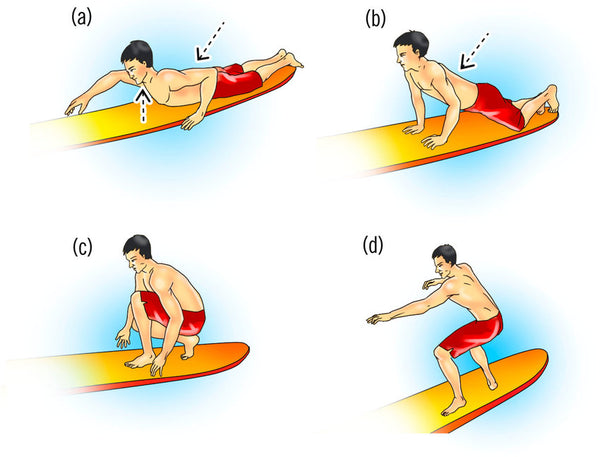How to Surf Better Part 3 of 9: Hand Placement During the Pop-Up
There are hundreds of different nuances and actions that go into good surfing, but we often spend the majority of our time only thinking about the most glamorous—things like arm placement during cutbacks or where the board sits in the face while riding the barrel.
But sometimes the best way to become a better surfer is to start with the simplest, most basic actions. Once you have those dialed, you can catch more waves, which means more time to practice the more exciting aspects of your surfing.

The Importance of the Pop-Up
The pop-up is something that most people spent very little time (if any) thinking about—and hand placement during a pop-up gets even less attention. But this is actually a very important consideration when you are surfing.
Beginner Technique
Beginners will generally have their hands parallel to each other and the rails when they pop up. This provides a stable platform and enables them to get up easier—something that isn’t necessarily a guarantee when you are first learning to surf.
However, at some point you’ll eventually progress to the point where pop-ups have become a natural, automatic action. This is when you will want to start thinking about how your pop-up can become more dynamic and contribute to your performance.
Proper Hand Placement
As many people eventually come to realize, good surfing requires the surfer’s chest to be open to the nose of the board, as this projects them down the line toward the shoulder of the wave. The sooner you can get your chest projecting down the line, the sooner the rail will engage and you can start generating speed. When your hands are parallel during takeoff, they form a natural barrier that keeps your chest from opening fully to the nose of your board. By taking off with your hands slightly offset (with the front hand slightly forward of the back arm), your body automatically aligns itself in the ideal position as you stand up, so that you are projecting down the line as soon as you get to your feet. In addition, standing up with your hands staggered like this helps you maintain extra pressure on the inside rail, which helps maintain control during steep takeoffs.
Common Mistakes
Another mistake that beginners often make when popping up is to grab their rails with their hands rather than pushing their palms down on the deck of the board. While this is not a critical error—in fact, some people pop up this way even when they become accomplished surfers—it does tend to add a bit of bounce or sway to the board during takeoff, in addition to breaking the water tension on the rails where the hands are overlapping.

Practice on a Longboard
A good way to practice pushing up with your hands on the deck of the board rather than the rails is to go longboarding. On longboards, you have a lot more time to take off on waves, so you can think about what you are doing and practice a bunch of different techniques. In addition, the slow, stylish approach to longboarding actually makes you want to take off with your palms on the deck, as you are often gliding into waves early and looking for the perfect moment to pop to your feet and stall into a good noseriding section. This feels much better when your hands are flat on the deck of your board, so you will be more likely to pop up in this manner naturally, without actually having to think about it.
Ultimately, good surfing is a combination of hundreds of small movements and techniques that all come together for the perfect ride. Start with the basics, such as pop-ups and hand placement when you are taking off. Once you have those perfected, you’ll be well on your way to a lifetime of shredding!
Check out this Instagram post for a visual reference to the tip in today’s blog.
Read More 👈